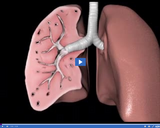
In the lungs, bronchi branch out into smaller and smaller tubes called "bronchioles."
- Subject:
- Science
- Provider:
- Utah Education Network
- Provider Set:
- Animations and Images 2011 Collection
- Author:
- Visual Learning Company
- Date Added:
- 08/18/2011

In the lungs, bronchi branch out into smaller and smaller tubes called "bronchioles."
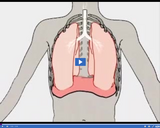
The diaphragm is a sheet of muscle below the lungs separating the chest cavity from the abdomen. When the diaphragm and the intercostal muscles contract, the size of the chest cavity increases.
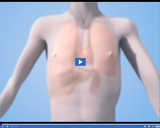
Under the ribs in your chest are two very important structures called "lungs." Lungs are the site of gas exchange.
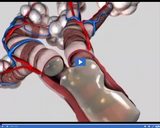
The body responds to these agents by accumulating fluid and debris in the alveoli. This inhibits the ability of the lungs to exchange oxygen. Another relatively common respiratory problem is bronchitis.

Breathing is controlled in a part of the brain generally referred to as the "respiratory center." Feedback is continually given to this part of the brain to adjust the rate of breathing.
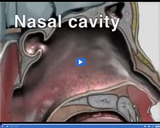
The nasal cavity and upper part of the respiratory system is lined with mucus membranes and small hairs that help accomplish these tasks. From the nasal cavity or mouth, air enters the pharynx, or throat.
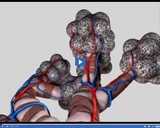
Smoking makes it difficult for oxygen to be exchanged through alveoli. It's estimated that at least one-third of the smoke inhaled from smoking coats alveoli with particles.

Chemoreceptors for smell, specifically referred to as "olfactory cells," are concentrated in mucus membranes lining the upper nasal cavity.
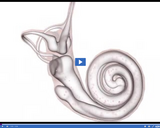
Inside the inner ear is a coiled, fluid-filled structure called the "cochlea." It plays a key role in hearing.
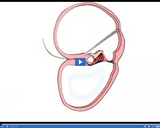
inside the cochlea are specialized hair cells that are sensitive to vibrations of sound waves. The hair cells transmit nerve impulses to the cochlear nerve that, in turn, transmits impulses to the brain, specifically, the cerebral cortex.
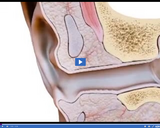
The middle ear region, located further inside the head, contains a delicate structure called the "tympanic membrane," commonly referred to as the "eardrum." The eardrum vibrates when sound waves make contact with it.
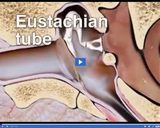
A small canal called the "Eustachian tube" leads from the middle ear to the throat. It helps equalize air pressure between the middle ear and the external environment.
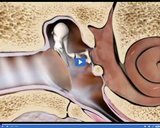
The eardrum vibrates when sound waves make contact with it. In turn, vibrations are transmitted to several tiny bones-- the hammer, anvil, and stirrup.
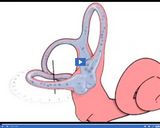
Structures in the inner ear, called "semicircular canals," contain fluid which help the body maintain balance. When the head changes position, receptors in the canals detect a change in the direction of the fluid.

The sounds we hear actually consist of disturbances in the air called "sound waves."
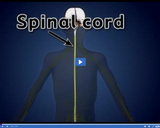
The spinal cord consists of a long bundle of neurons running the length of the back.

Compact bone is very dense and provides support. It is found in the shafts of long bones such as in the legs and arms.
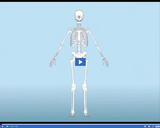
You're probably familiar with some of the major bones, such as the femur, tibia, ulna, radius, humerus, and ribs.
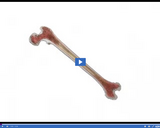
Red marrow found in long bones, breastbone, cranium, and vertebrae is responsible for producing red blood cells, platelets, and some types of white blood cells. Yellow marrow consists of fat cells, and is found in the hollow centers of long bones.
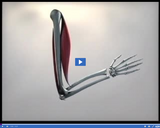
Because a muscle exerts force only when it contracts, it moves a bone in just one direction. Therefore muscles often work in pairs, with muscles moving in opposite directions.